Opinion & Analysis
An early look at the potential U.S. Ryder Cup Team
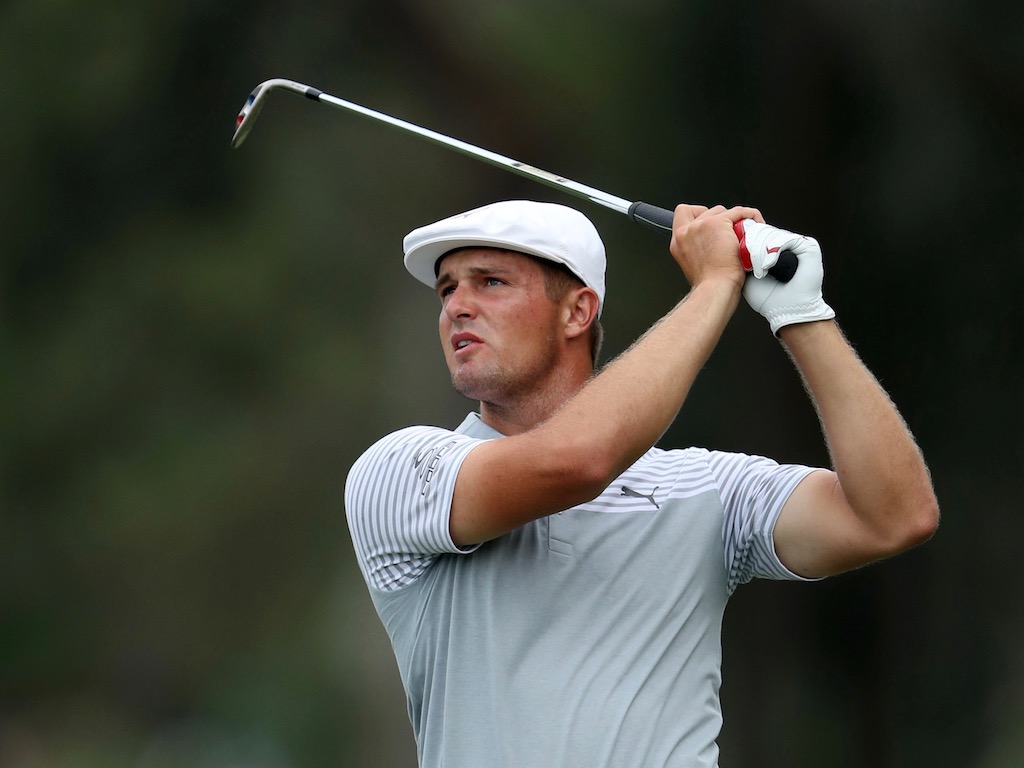
With the Masters and the Players Championship complete, I wanted to examine the statistics of the current leaders in Ryder Cup Points for the U.S. Team. Over the history of the Ryder Cup, the U.S. Team has relied on pairings that were friends and practice-round companions instead of pairing players that were more compatible from a statistical standpoint. This has led to disappointing performances from the U.S. Team and top players such as Jim Furyk performing poorly at the Ryder Cup, as he is ill-suited for the Fourball format.
After a disastrous 2014 Ryder Cup where the U.S. Team lost by a score of 16.5-11.5, the U.S. decided to use a more statistical approach to Ryder Cup play. According to my calculations, the 2016 U.S. Team’s pairings were the closest to optimal that the U.S. Team has compiled in the last seven Ryder Cups. And not surprisingly, the U.S. Team won 17-11 over the Europeans.
Since there are several months to go before the Ryder Cup, I won’t get too much into potential pairings in this article. Instead, I will focus more on the current games of top-12 players in U.S. Ryder Cup Points Standings and how that translates to Ryder Cup performance.
About the Ryder Cup Format
In the Ryder Cup, there is the Foursome format (alternate shot) and the Fourball format (best score). There are distinctly different metrics in the game that correlate to quality performers in each format.
In the Foursome format, short game around the green performance is usually critical. In a typical stroke play event such as The Players Championship, short game around the green performance usually has a much smaller impact on player’s performance. But in a match play, alternate-shot format the opposite has been true. My conclusion is that with the alternate-shot format, more greens in regulation are likely to be missed. The team that can save par and extend holes is usually likely to come out on top. The European team has mostly dominated the U.S. team over the past 20 years in the Foursome format, and the European teams typically are stronger with their short game around the green.
Other factors involved with Foursome play are Red Zone Performance (shots from 175-225 yards) and being able to pair the right players together based on how they each play off the tee and with their approach shots from the rough. For example, a pairing of Phil Mickelson (who misses a lot of fairways) and Zach Johnson (who is not very good from the rough) would likely be a poor pairing.
In the Fourball format (lowest score), the best performers are high birdie makers and players that perform well on the par-4s, par-5s, and par-3s. Bubba Watson makes a lot of birdies and plays the par-4s and par-5s well, thus making him a good candidate for the Fourball format. The only issue with Bubba in the past is he has occasionally struggled on the par-3s. That can be resolved by pairing him with a player who makes a lot of birdies and is a strong performer on the par-3s. The reason for Jim Furyk’s struggles in the Fourball format is that he does not make a lot of birdies and is a merely average performer on the par-5s.
Note: All rankings below are based out of 209 golfers.
1. Patrick Reed
In the past, it has been difficult to get an accurate depiction of Reed’s game. He was notorious for either getting into contention or blowing up if he wasn’t in contention after the first round. He is now far better at avoiding those blowup rounds and remaining competitive regardless of how he well he performs at the beginning of the tournament. His iron play has been excellent, and since he is good on approach shots from the rough, short game around the green and he makes a lot of birdies and plays the par-4s and par-5s well, he should continue to be a great competitor in the Ryder Cup format. Given his inability to find the fairway off the tee, however, I would recommend pairing him with a quality performer from the rough in the alternate shot format.
2. Justin Thomas
On paper, Thomas should be Team USA’s toughest competitor as he has little in the way of holes in his game. He drives it great, hits his irons well from every distance, has a superb short game and can putt. He also makes a ton of birdies, plays every type of hole well and rarely makes bogeys. Like Reed, it would be advisable to pair him with a player that is a quality performer from the rough in the alternate shot format.
3. Dustin Johnson
DJ is the second-strongest performer on paper. The only thing that currently separates Justin Thomas from DJ is their Red Zone play. DJ has typically been a world-class performer from the Red Zone, however, and the data suggests that his ranking from the Red Zone should rapidly improve. He struck it well from the Red Zone in his last two events at Harbour Town Golf Links and TPC Sawgrass. And with his putting performance this season, he could make for a great competitor in this year’s Ryder Cup.
4. Jordan Spieth
Spieth has the metrics to be a strong Ryder Cup performer, as he strikes the ball well with his driver and his irons while having a superb short game around the green. His only weakness in the Fourball format is his performance on the par-3s, but that is due to his inability to make putts from 15-25 feet (198th). That is the crux of the situation for Spieth; can he get his old putting form back?
A look at previous great putters on Tour that inexplicably struggled with their putter shows that Spieth is going about his putting woes the correct way. He’s not making equipment or wholesale changes to his putting stroke. He is continuing to work with what made him a great putter just like Jason Day did last year when he inexplicably struggled with the putter early in the season… and then turned it around and regained his old putting form.
The question is, how long will it take for Spieth to regain his old form? Typically, players like Spieth that have a dramatic drop-off in their putting take about a year to regain their old form. He may not regain that form by the time the Ryder Cup takes place. If he does, Team USA is very strong with its top-4 points earners.
5. Bubba Watson
Bubba is off to a strong enough year to make the U.S. Ryder Cup Team, but the best bet for him is to stick to the Fourball format given his struggles around the green. Watson’s performance on the par-5s has not exactly been remarkable, but typically he’s one of the very best in the world on par-5s and can make a ton of birdies.
6. Rickie Fowler
Fowler has not been as strong in some areas of the game such as Red Zone, shots from the rough and putting as he has been in recent years. That makes him a little less appealing in the alternate shot format, but he still has a solid foundation to be a quality contributor in either format. The upside is if Rickie gets back to his old form with the putter and from the Red Zone, he should be a top-notch Ryder Cup performer because he is well suited to perform in either team format. At this time, he would be best suited to play with an accurate driver and very good performer around the green (i.e. Matt Kuchar) in the alternate shot format.
7. Brooks Koepka
There currently is not enough data on Koepka due to his wrist injury he suffered early in the season. Koepka is arguably the best bomber in the world who is also a great putter and a solid performer from the Red Zone. The main issue for Koepka has been his short game performance around the green. That would typically make for a weak partner in the alternate shot format, but Koepka was spectacular in the 2016 Ryder Cup. His combination of length and putting may make him a formidable Ryder Cup performer for years to come.
8. Phil Mickelson
As a statistical analyst for golf, I never quite know what I’m going to get from Lefty. This season Lefty has putted superbly, but his performance around the green has left a lot to be desired.
In recent Ryder Cups, he has been a quality performer in both the Foursome and Fourball formats. His recent success in the alternate shot format makes him a mandatory candidate, however, his inability to find the fairway means he would need a partner who is very good from the rough. The data suggests that his performance around the green should get closer to his old form as the season goes along.
9. Webb Simpson
Like Mickelson, it’s always a surprise as to what the strengths and weaknesses of Simpson’s game will be by the end of the season. Typically, he’s been a decent driver of the ball that is often a superb iron player and short game performer. With the anchoring ban, he has struggled with the putter up to this season. Lately, he has been an incredible putter that is struggling a bit with the irons.
Most of Simpson’s struggles with the irons have been from the rough, so a partner who finds a lot of fairways off the tee could be an excellent pairing in the foursome format with Simpson.
10. Matt Kuchar
Kuchar could be a very critical player for Team USA down the stretch. There are potential players on the team that could be valuable in the alternate shot format if they can find a teammate to find fairways off the tee to make up for their struggles on approach shots from the rough. Historically, Kuchar has been the most accurate off the tee of the players mentioned thus far.
This season, however, Kuchar has been underwhelming in his ability to find the fairway. The next most-accurate drivers of the ball that are near the top-12 in Ryder Cup points are Brian Harman, Bryson DeChambeau, Kevin Kisner and Andrew Landry, and none of them have nearly the experience in the Ryder Cup as Kuchar has. If Kuchar continues to miss fairways, his chances of making the team are not good unless he’s a Captain’s pick. If he cannot find the fairway, he has little-projected value as a member of the team. He is not making a lot of birdies, and his struggles on the par-3s and does not make him a favorable teammate in the Fourball format either.
11. Brian Harman
Harman’s value is that he has fairly decent Fourball metrics and his accuracy off the tee, putting, and iron play can work well with players like Fowler, Simpson, and Kuchar in the alternate shot format.
Harman has not performed that well from around the green using the Strokes Gained methodology, however; he ranks 15th on shots from 10-20 yards. I placed that metric in there as strokes gained takes into account all shots from less than 30 yards, but 10-20 yards is the most common distance range from which scrambling opportunities occur on Tour. Thus, Harman is an excellent performer from 10-20 yards and is only losing strokes around the green due to poor performance from 20-30 yards, and those shots occur less frequently on Tour. His struggles from 20-30 yards would also explain why his par-5 performance is roughly average, as that is the distance players typically finish from the hole when they go for par-5s in two and do not make the green.
And even though Harman is not very long off the tee (147th in Measured Driving Distance), he is a quality performer from the rough and thus he does not have to be tethered to another short-hitting, accurate driver in the alternate shot format.
12. Bryson DeChambeau
Dechambeau makes for a solid Ryder Cup candidate, as he has no outstanding weaknesses in his game this season as he appears to have rid himself of the putting woes that have hurt him in the past. I think he is better suited for the Fourball format, however, given how many birdies he makes. Pair him with a strong performer on the par-3s like Rickie Fowler or Phil Mickelson and it would make a very formidable duo in that format.
A pairing with Mickelson in the Fourball format would be intriguing given DeChambeau’s excellent driving. DeChambeau could hit first and — if he continues to drive it superbly — that would free up Mickelson to not worry so much about his woeful driving and focus more on making birdies. Perhaps a Fourball pairing with Bubba would make for a situation where DeChambeau could tee off first and pipe his drive, and then give Bubba a free rip to hit it as far as he possibly can and give them a sizeable advantage over their opponents.
31. Tiger Woods
I know I said I was only going to look at the top-12 players in Ryder Cup points, but the readers would inevitably ask about Tiger anyway. Furthermore, Tiger is an intriguing candidate for the team given his current game.
Tiger has struggled in both the Foursome and Fourball format. He seems to not play that great in alternate shot. In Fourball, it appears that he plays well by himself, but he is often let down by his teammates. The Europeans have always gunned for Tiger in the Ryder Cup, and it takes a special type of teammate to deal with the hysteria of having Tiger as their partner.
There are the makings of a very good alternate shot partner with Tiger, as his iron play and putting are still really good and his short game has been incredible this season. In the Fourball format, it would be advisable to find a strong par-5 performer, as Tiger’s performance on the par-5s has not been outstanding thus far. Having said that, I could see three excellent partners for Tiger in either format.
Patrick Reed has the numbers to be compatible with Tiger’s game, and he also has the track record of living up to the moment in the Ryder Cup. Dustin Johnson is can make up for Tiger’s possible big misses off the tee and can overpower a course with Tiger. And Phil Mickelson, whose game is compatible with Tiger’s, and could provide a symbol of the old guard working together to beat the Europeans.
There are certainly a lot of compelling possible pairings for Team USA, and there is still a long way to go before we start to see what pairings are available. The European Team looks like one of the strongest in years, and with all of the potential storylines for the 2018 Ryder Cup, it could be one of the greatest Ryder Cups of all time.
- LIKE59
- LEGIT4
- WOW6
- LOL1
- IDHT1
- FLOP1
- OB1
- SHANK9
Opinion & Analysis
The Wedge Guy: What really makes a wedge work? Part 1

Of all the clubs in our bags, wedges are almost always the simplest in construction and, therefore, the easiest to analyze what might make one work differently from another if you know what to look for.
Wedges are a lot less mysterious than drivers, of course, as the major brands are working with a lot of “pixie dust” inside these modern marvels. That’s carrying over more to irons now, with so many new models featuring internal multi-material technologies, and almost all of them having a “badge” or insert in the back to allow more complex graphics while hiding the actual distribution of mass.
But when it comes to wedges, most on the market today are still single pieces of molded steel, either cast or forged into that shape. So, if you look closely at where the mass is distributed, it’s pretty clear how that wedge is going to perform.
To start, because of their wider soles, the majority of the mass of almost any wedge is along the bottom third of the clubhead. So, the best wedge shots are always those hit between the 2nd and 5th grooves so that more mass is directly behind that impact. Elite tour professionals practice incessantly to learn to do that consistently, wearing out a spot about the size of a penny right there. If impact moves higher than that, the face is dramatically thinner, so smash factor is compromised significantly, which reduces the overall distance the ball will fly.
Every one of us, tour players included, knows that maddening shot that we feel a bit high on the face and it doesn’t go anywhere, it’s not your fault.
If your wedges show a wear pattern the size of a silver dollar, and centered above the 3rd or 4th groove, you are not getting anywhere near the same performance from shot to shot. Robot testing proves impact even two to three grooves higher in the face can cause distance loss of up to 35 to 55 feet with modern ‘tour design’ wedges.
In addition, as impact moves above the center of mass, the golf club principle of gear effect causes the ball to fly higher with less spin. Think of modern drivers for a minute. The “holy grail” of driving is high launch and low spin, and the driver engineers are pulling out all stops to get the mass as low in the clubhead as possible to optimize this combination.
Where is all the mass in your wedges? Low. So, disregarding the higher lofts, wedges “want” to launch the ball high with low spin – exactly the opposite of what good wedge play requires penetrating ball flight with high spin.
While almost all major brand wedges have begun putting a tiny bit more thickness in the top portion of the clubhead, conventional and modern ‘tour design’ wedges perform pretty much like they always have. Elite players learn to hit those crisp, spinny penetrating wedge shots by spending lots of practice time learning to consistently make contact low in the face.
So, what about grooves and face texture?
Grooves on any club can only do so much, and no one has any material advantage here. The USGA tightly defines what we manufacturers can do with grooves and face texture, and modern manufacturing techniques allow all of us to push those limits ever closer. And we all do. End of story.
Then there’s the topic of bounce and grinds, the most complex and confusing part of the wedge formula. Many top brands offer a complex array of sole configurations, all of them admittedly specialized to a particular kind of lie or turf conditions, and/or a particular divot pattern.
But if you don’t play the same turf all the time, and make the same size divot on every swing, how would you ever figure this out?
The only way is to take any wedge you are considering and play it a few rounds, hitting all the shots you face and observing the results. There’s simply no other way.
So, hopefully this will inspire a lively conversation in our comments section, and I’ll chime in to answer any questions you might have.
And next week, I’ll dive into the rest of the wedge formula. Yes, shafts, grips and specifications are essential, too.
- LIKE13
- LEGIT4
- WOW1
- LOL1
- IDHT2
- FLOP2
- OB1
- SHANK1
Golf's Perfect Imperfections
Golf’s Perfect Imperfections: Amazing Session with Performance Coach Savannah Meyer-Clement

In this week’s episode, we spent some time with performance coach Savannah Meyer-Clement who provides many useful insights that you’ll be able to implement on the golf course.
- LIKE0
- LEGIT0
- WOW0
- LOL0
- IDHT0
- FLOP0
- OB0
- SHANK0
19th Hole
Vincenzi’s 2024 RBC Heritage betting preview: Patrick Cantlay ready to get back inside winner’s circle

Just a two-hour drive from Augusta National, the PGA TOUR heads to Harbour Town Golf Links in Hilton Head Island, S.C. Hilton Head Island is a golfer’s paradise and Harbour Town is one of the most beautiful and scenic courses on the PGA TOUR.
Harbour Town Golf Links is a par-71 that measures 7,121 yards and features Bermuda grass greens. A Pete Dye design, the course is heavily tree lined and features small greens and many dog legs, protecting it from “bomb-and-gauge” type golfers.
The field is loaded this week with 69 golfers with no cut. Last year was quite possibly the best field in RBC Heritage history and the event this week is yet another designated event, meaning there is a $20 million prize pool.
Most of the big names on the PGA Tour will be in attendance this week with the exceptions of Hideki Matsuyama and Viktor Hovland. Additionally, Webb Simpson, Shane Lowry, Gary Woodland and Kevin Kisner have been granted sponsors exemptions.
Past Winners at Harbour Town
- 2023: Matt Fitzpatrick (-17)
- 2022: Jordan Spieth (-13)
- 2021: Stewart Cink (-19)
- 2020: Webb Simpson (-22)
- 2019: CT Pan (-12)
- 2018: Sotoshi Kodaira (-12)
- 2017: Wesley Bryan (-13)
- 2016: Branden Grace (-9)
- 2015: Jim Furyk (-18)
In this article and going forward, I’ll be using the Rabbit Hole by Betsperts Golf data engine to develop my custom model. If you want to build your own model or check out all of the detailed stats, you can sign up using promo code: MATTVIN for 25% off any subscription package (yearly is best value).
Key Stats For Harbour Town
Let’s take a look at key metrics for Harbour Town Golf Links to determine which golfers boast top marks in each category over their past 24 rounds.
Strokes Gained: Approach
Strokes Gained: Approach is exceedingly important this week. The greens at Harbour Town are about half the size of PGA TOUR average and feature the second-smallest greens on the tour. Typical of a Pete Dye design, golfers will pay the price for missed greens.
Total SG: Approach Over Past 24 Rounds
- Scottie Scheffler (+1.27)
- Tom Hoge (+1.27)
- Corey Conners (+1.16)
- Austin Eckroat (+0.95)
- Cameron Young (+0.93)
Good Drive %
The fairways at Harbour Town are tree lined and feature many dog legs. Bombers tend to struggle at the course because it forces layups and doesn’t allow long drivers to overpower it. Accuracy is far more important than power.
Good Drive % Over Past 24 Rounds
- Brice Garnett (88.8%)
- Shane Lowry (+87.2%)
- Akshay Bhatia (+86.0%)
- Si Woo Kim (+85.8%)
- Sepp Straka (+85.1%)
Strokes Gained: Total at Pete Dye Designs
Pete Dye specialists tend to play very well at Harbour Town. Si Woo Kim, Matt Kuchar, Jim Furyk and Webb Simpson are all Pete Dye specialists who have had great success here. It is likely we see some more specialists near the top of the leaderboard this week.
SG: TOT Pete Dye per round over past 36 rounds:
- Xander Schauffele (+2.27)
- Scottie Scheffler (+2.24)
- Ludvig Aberg (+2.11)
- Brian Harman (+1.89)
- Sungjae Im (+1.58)
4. Strokes Gained: Short Game (Bermuda)
Strokes Gained: Short Game factors in both around the green and putting. With many green-side bunkers and tricky green complexes, both statistics will be important. Past winners — such as Jim Furyk, Wes Bryan and Webb Simpson — highlight how crucial the short game skill set is around Harbour Town.
SG: SG Over Past 24 Rounds
- Jordan Spieth (+1.11)
- Taylor Moore (+1.02)
- Wyndham Clark (+0.98)
- Mackenzie Hughes (+0.86)
- Andrew Putnam (+0.83)
5. Greens in Regulation %
The recipe for success at Harbour Town Golf Links is hitting fairways and greens. Missing either will prove to be consequential — golfers must be in total control of the ball to win.
Greens in Regulation % over past 24 rounds:
- Brice Garnett (+75.0%)
- Scottie Scheffler (+69.9%)
- Corey Conners (+69.0%)
- Shane Lowry (+68.3%)
- Patrick Rodgers (+67.6%)
6. Course History
Harbour Town is a course where players who have strong past results at the course always tend to pop up.
Course History over past 24 rounds:
- Patrick Cantlay (+2.34)
- Cam Davis (+2.05)
- J.T. Poston (+1.69)
- Justin Rose (+1.68)
- Tommy Fleetwood (+1.59)
The RBC Heritage Model Rankings
Below, I’ve compiled overall model rankings using a combination of the five key statistical categories previously discussed — SG: Approach (24%), Good Drives (20%), SG: SG (14%), SG: Pete Dye (14%), GIR (14%), and Course History (14%)
- Shane Lowry
- Russell Henley
- Scottie Scheffler
- Xander Schauffele
- Corey Conners
- Wyndham Clark
- Christiaan Bezuidenhout
- Matt Fitzpatrick
- Cameron Young
- Ludvig Aberg
2024 RBC Heritage Picks
Patrick Cantlay +2000 (FanDuel)
With the exception of Scottie Scheffler, the PGA Tour has yet to have any of their star players show peak form during the 2024 season. Last week, Patrick Cantlay, who I believe is a top-5 players on the PGA Tour, took one step closer to regaining the form that’s helped him win eight events on Tour since 2017.
Cantlay limped into the Masters in poor form, but figured it out at Augusta National, finishing in a tie for 20th and ranking 17th for the week in Strokes Gained: Ball Striking. The former FedEx Cup champion will now head to one of his favorite golf courses in Harbour Town, where he’s had immaculate results over the years. In his six trips to the course, he’s only finished worse than 7th one time. The other finishes include three third places (2017, 2019, 2023) and one runner-up finish (2022). In his past 36 rounds at Harbour Town, Cantlay ranks 1st in Strokes Gained: Total per round at the course by a wide margin (+2.36).
Cantlay is winless since the 2022 BMW Championship, which is far too long for a player of his caliber. With signs pointing to the 32-year-old returning to form, a “signature event” at Harbour Town is just what he needs to get back on the winning track.
Tommy Fleetwood +3000 (FanDuel)
I truly believe Tommy Fleetwood will figure out a way to win on American soil in 2024. It’s certainly been a bugaboo for him throughout his career, but he is simply too talented to go another season without winning a PGA Tour event.
At last week’s Masters Tournament, Fleetwood made a Sunday charge and ended up finishing T3 in the event, which was his best ever finish at The Masters. For the week, the Englishman ranked 8th in the field in Strokes Gained: Approach, 10th in Strokes Gained: Ball Striking and 16th in Strokes Gained: Putting.
Harbour Town is a perfect layout for Fleetwood, and he’s had relative success at this Pete Dye design in the past. In his four trips to the course, he’s finished inside of the top 25 three times, with his best finish, T10, coming in 2022. The course is pretty short and can’t be overpowered, which gives an advantage to more accurate players such as Fleetwood. Tommy ranks 8th in the field in Good Drive % and should be able to plot his way along this golf course.
The win is coming for Tommy lad. I believe there’s a chance this treasure of a golf course may be the perfect one for him to finally break through on Tour.
Cameron Young +3300 (FanDuel)
Cameron Young had a solid Masters Tournament last week, which is exactly what I’m looking for in players who I anticipate playing well this week at the RBC Heritage. He finished in a tie for 9th, but never felt the pressure of contending in the event. For the week, Young ranked 6th in Strokes Gained: Off the Tee and 6th in Strokes Gained: Ball Striking.
Despite being one of the longest players off the tee on the PGA Tour, Young has actually played some really good golf on shorter tracks. He finished T3 at Harbour Town in 2023 and ranks 20th in the field in Good Drive% and 16th in Greens in Regulation in his past 24 rounds. He also has strong finishes at other shorter courses that can take driver out of a players hand such as Copperhead and PGA National.
Young is simply one of the best players on the PGA Tour in 2024, and I strongly believe has what it takes to win a PGA Tour event in the very near future.
Corey Conners +5500 (FanDuel)
Corey Conners has had a disappointing year thus far on the PGA Tour, but absolutely loves Harbour Town.
At last week’s Masters Tournament, the Canadian finished T30 but ranked 20th in the field in Strokes Gained: Approach. In his past 24 rounds, Conners ranks 3rd in the field in Strokes Gained: Approach, 3rd in Greens in Regulation % and 24th in Good Drive %.
In Conners’ last four trips to Harbour Town, his worst finish was T31, last season. He finished T4 in 2021, T12 in 2022 and ranks 8th in Strokes Gained: Total at the course over his past 36 rounds.
Conners hasn’t been contending, but his recent finishes have been encouraging as he has finished in the top-25 in each of his past three starts prior to The Masters, including an impressive T13 at The PLAYERS. His recent improvement in ball striking as well as his suitability for Harbour Town makes Conners a high upside bet this week.
Shane Lowry (+7500) (FanDuel)
When these odds were posted after Lowry was announced in the field, I have to admit I was pretty stunned. Despite not offering much win equity on the PGA Tour over the last handful of years, Shane Lowry is still a top caliber player who has the ability to rise to the top of a signature event.
Lowry struggled to score at The Masters last week, but he actually hit the ball really well. The Irishman ranked 1st for Strokes Gained: Approach on the week and 7th in Strokes Gained: Ball Striking. As usual, it was the putter that let him down, as he ranked 60th in the field in Strokes Gained: Putting.
Harbour Town is most definitely one of Lowry’s favorite courses on the PGA Tour. In his six starts there, he’s finished in the top 10 three times, including third twice. Lowry is sensational at Pete Dye designs and ranks 7th in Strokes Gained: Total in his past 36 rounds on Dye tracks.
Lowry is perfect for Harbour Town. In his past 24 rounds, he ranks 5th in Strokes Gained: Approach, 2nd in Good Drive% and 5th in Green in Regulation %. If he figures it out on the greens, Shane could have his first win in America since 2015.
Lucas Glover +12000 (FanDuel)
This is one of my weekly “bet the number” plays as I strongly believe the odds are just too long for a player of Glover’s caliber. The odds have been too long on Glover for a few weeks now, but this is the first event that I can get behind the veteran being able to actually contend at.
Glover is quietly playing good golf and returning to the form he had after the understandable regression after his two massive victories at the end of 2023. He finished T20 at The Masters, which was his best ever finish at Augusta National. For the week, Lucas ranked 18th for Strokes Gained: Approach and 20th in Strokes Gained: Ball Striking.
Over his past 24 rounds, Glover ranks 9th in Strokes Gained: Approach and 13th in Good Drive %. Harbour Town is a short course that the 44-year-old will be able to keep up with the top players on Tour off the tee. He’s played the course more than 20 times, with mixed results. His best finishes at Harbour Town include a T7 in 2008, but recently has a finish of T21 in 2020.
Glover has proven he can contend with the stars of the Tour on any given week, and this number is flat out disrespectful.
- LIKE30
- LEGIT5
- WOW2
- LOL1
- IDHT1
- FLOP2
- OB0
- SHANK2
-

 19th Hole1 week ago
19th Hole1 week agoDave Portnoy places monstrous outright bet for the 2024 Masters
-

 19th Hole3 weeks ago
19th Hole3 weeks agoThings got heated at the Houston Open between Tony Finau and Alejandro Tosti. Here’s why
-

 19th Hole1 week ago
19th Hole1 week agoTiger Woods arrives at 2024 Masters equipped with a putter that may surprise you
-

 19th Hole2 weeks ago
19th Hole2 weeks agoReport: Tiger Woods has ‘eliminated sex’ in preparation for the 2024 Masters
-

 19th Hole4 days ago
19th Hole4 days agoTwo star names reportedly blanked Jon Rahm all week at the Masters
-

 19th Hole4 days ago
19th Hole4 days agoNeal Shipley presser ends in awkward fashion after reporter claims Tiger handed him note on 8th fairway
-

 19th Hole3 days ago
19th Hole3 days agoReport: LIV Golf identifies latest star name they hope to sign to breakaway tour
-

 19th Hole2 weeks ago
19th Hole2 weeks agoAddiction, spinal fusion, and scam artists – Everything Anthony Kim revealed in candid interview with David Feherty

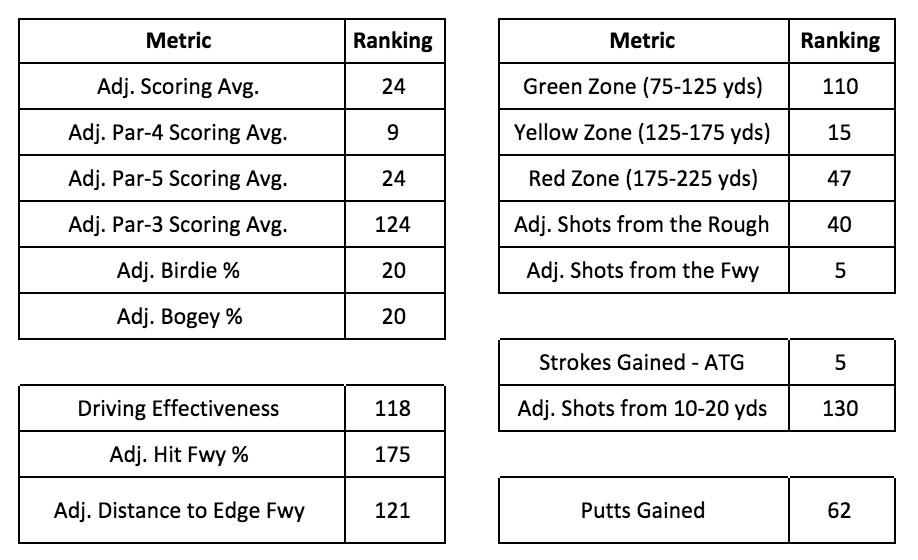
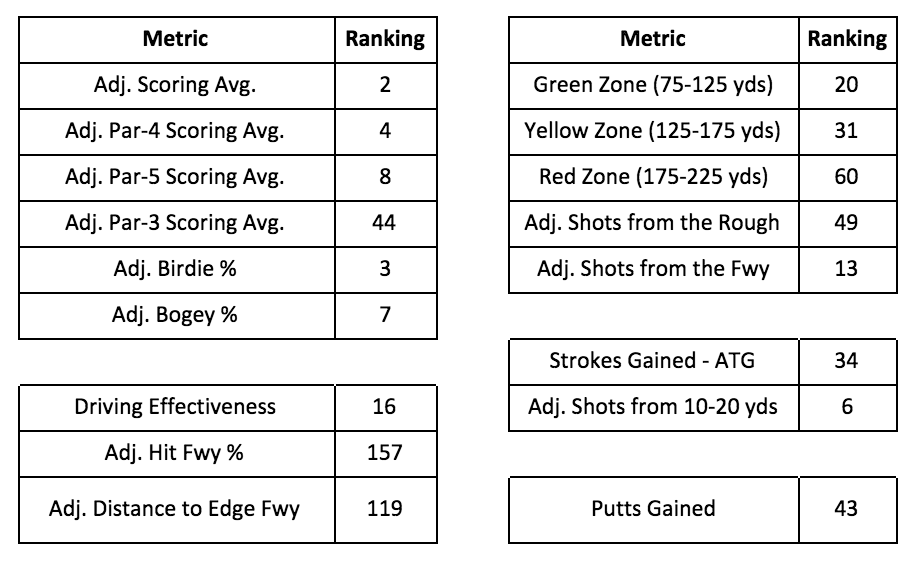
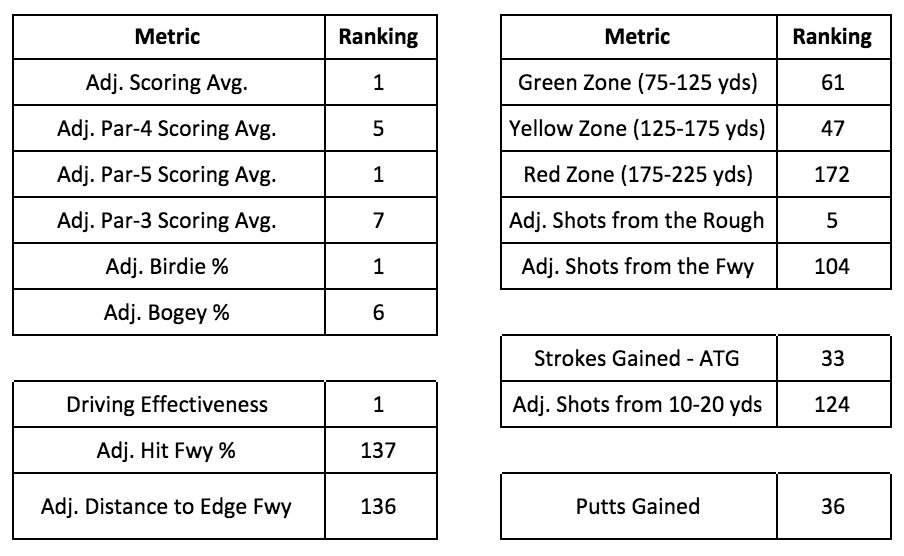
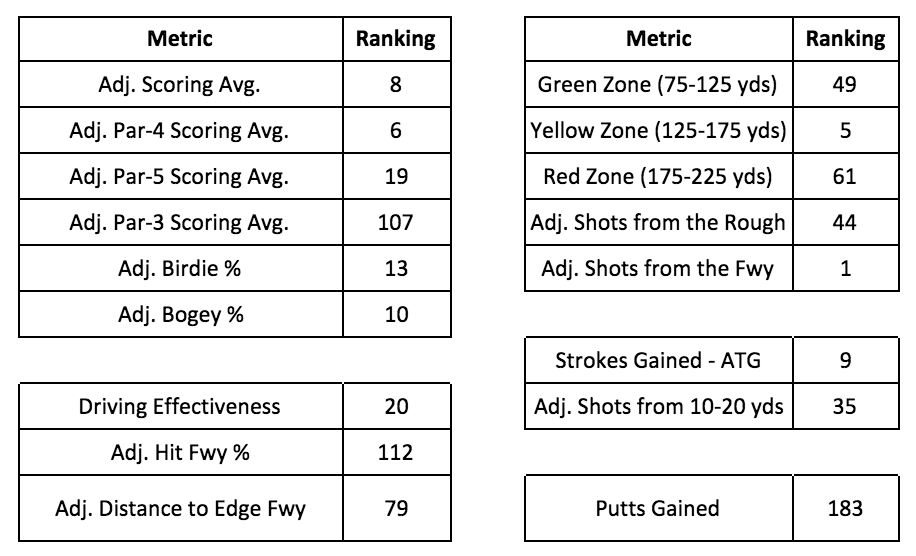
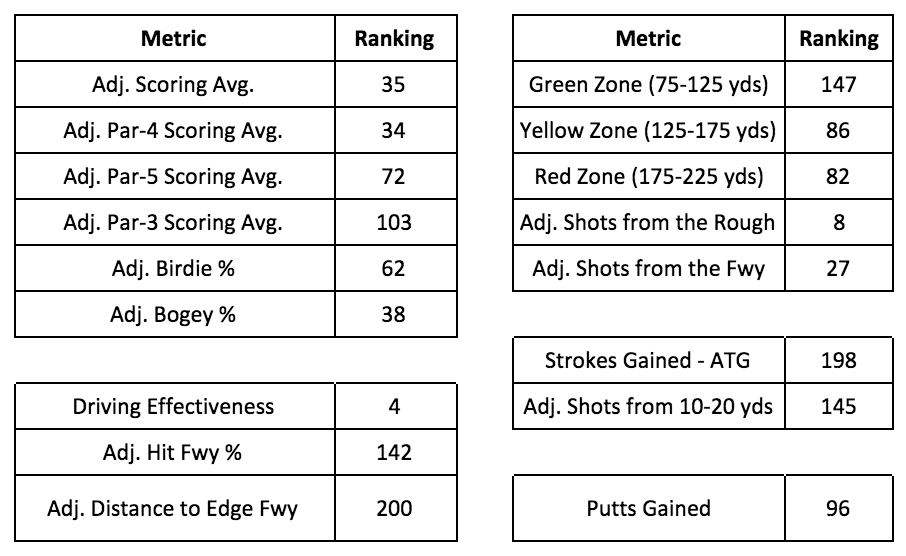

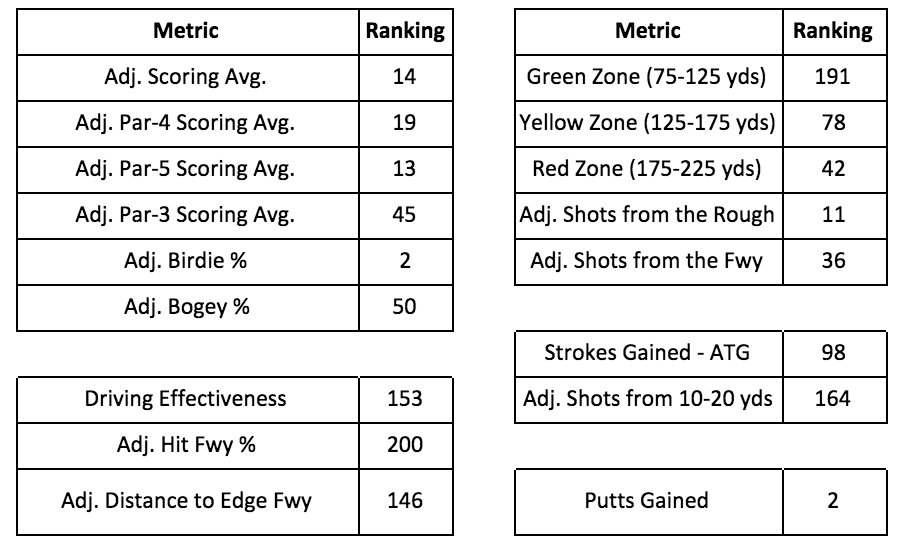


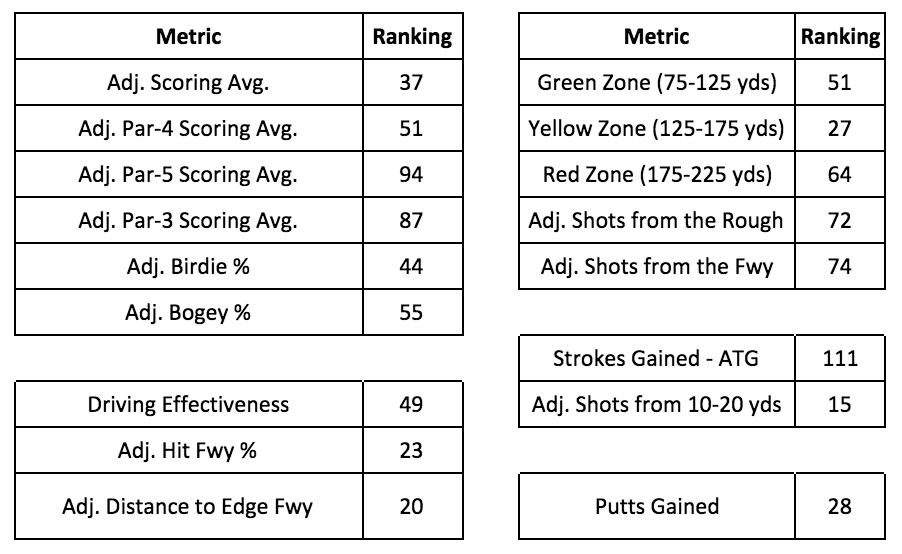
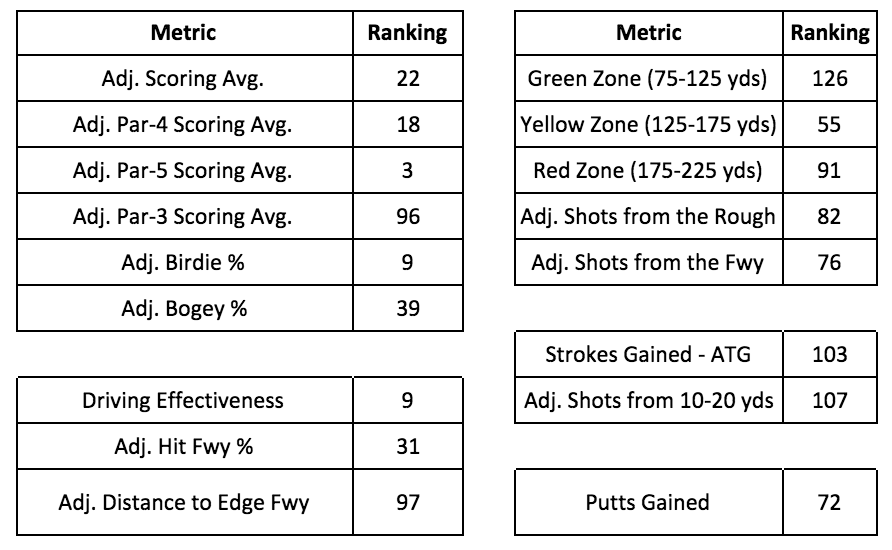
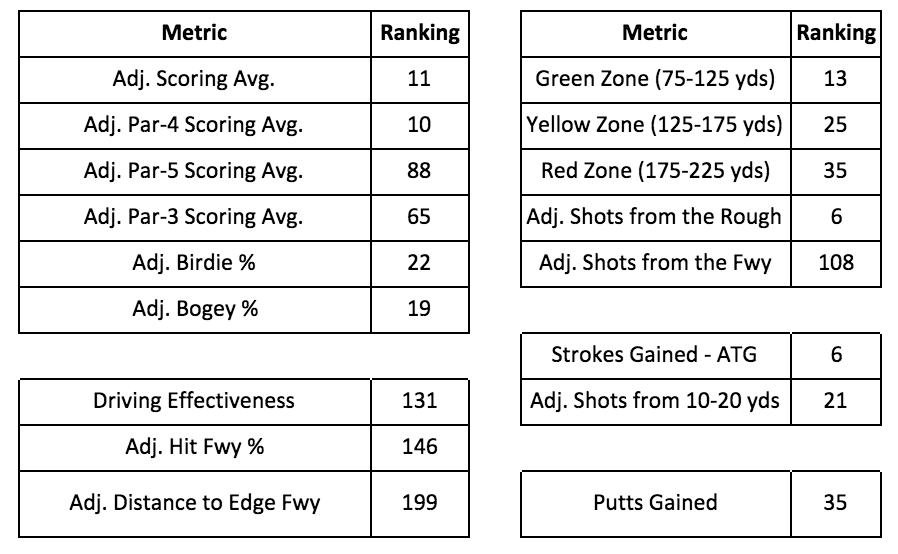










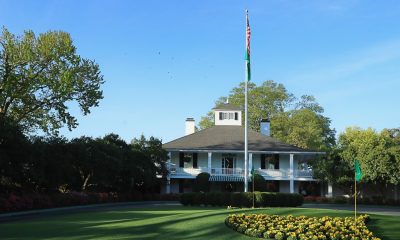

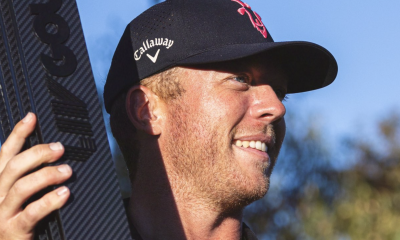














2putttom
May 24, 2018 at 1:37 pm
we need a rookie / 2nd yr. player on there.
ogo
May 24, 2018 at 12:16 pm
Aaaaah … the U.S. Tribal Ryder Cup Tribal Team ….. 😮
Tyler
May 24, 2018 at 2:43 pm
It couldn’t get any worse than Tom Watson’s picks. I lost a lot of respect for him over those.
moses
May 24, 2018 at 11:32 am
Hopefully Tiger continues his good play to become a Captain’s pick.
ogo
May 24, 2018 at 12:17 pm
…. as long as he doesn’t kneel during the playing of the national anthem … 😛
3PuttPar
May 24, 2018 at 10:20 am
“In the Fourball format (lowest score), the best performers are high birdie makers and players that perform well on the par-4s, par-5s, and par-3s.”
Sooo players that perform well on all holes? What other holes are left? LOL
James Glenn
May 24, 2018 at 10:05 am
Rich, love the work — but doubt you need to include the metric of “performing well on par-4s, par-5s, and par-3s.” That covers every hole in golf, so essentially we want players who perform well on every hole? Otherwise, love it.
Rich Hunt
May 24, 2018 at 2:44 pm
I will give an example of what I mean by it.
Typically, Bubba Watson dominates the par-4’s and par-5’s. On Tour, par-4 performance is the most important of the holes with regards to its correlation to success on Tour. The reason why is that the average Tour player plays 10-11 par-4’s per round. Despite dominating the par-4’s and par-5’s, Bubba tends to struggle on the par-3’s over his career. He will still be one of the very top players in the US, but having him in the Fourball format can create a glaring deficiency on the par-3’s if he’s not paired with a good par-3 performer.
Other players may not quite dominate the par-4’s and par-5’s like Bubba does. But, if they are sound performers on the par-4’s, par-5’s and par-3’s and make quite a few birdies…then they may very well be better suited for the Fourball format over Bubba.